Product & Service Development: Processes, Lifecycle, and Banking App
VerifiedAdded on 2023/02/02
|10
|3310
|86
Report
AI Summary
This report delves into the multifaceted realm of product and service development, providing a comprehensive overview of the processes and stages involved. It begins by outlining the fundamental steps in product and service development, including idea generation, screening, concept development, business analysis, product development, test marketing, commercialization, and launch. The report then explores the application development process, specifically focusing on the creation of a banking application, detailing steps such as idea validation, design, development, testing, launching, marketing, and maintenance. Furthermore, it examines the product lifecycle stages, including development, introduction, growth, maturity, and decline, within the context of Nedbank's product portfolio. The report also discusses product line management choices, emphasizing understanding consumer needs, shaping ideas, validating plans, defining offers, and validating pricing. The report concludes by evaluating the different stages of the banking application life cycle, providing a framework for understanding the development and management of products and services in the financial sector.
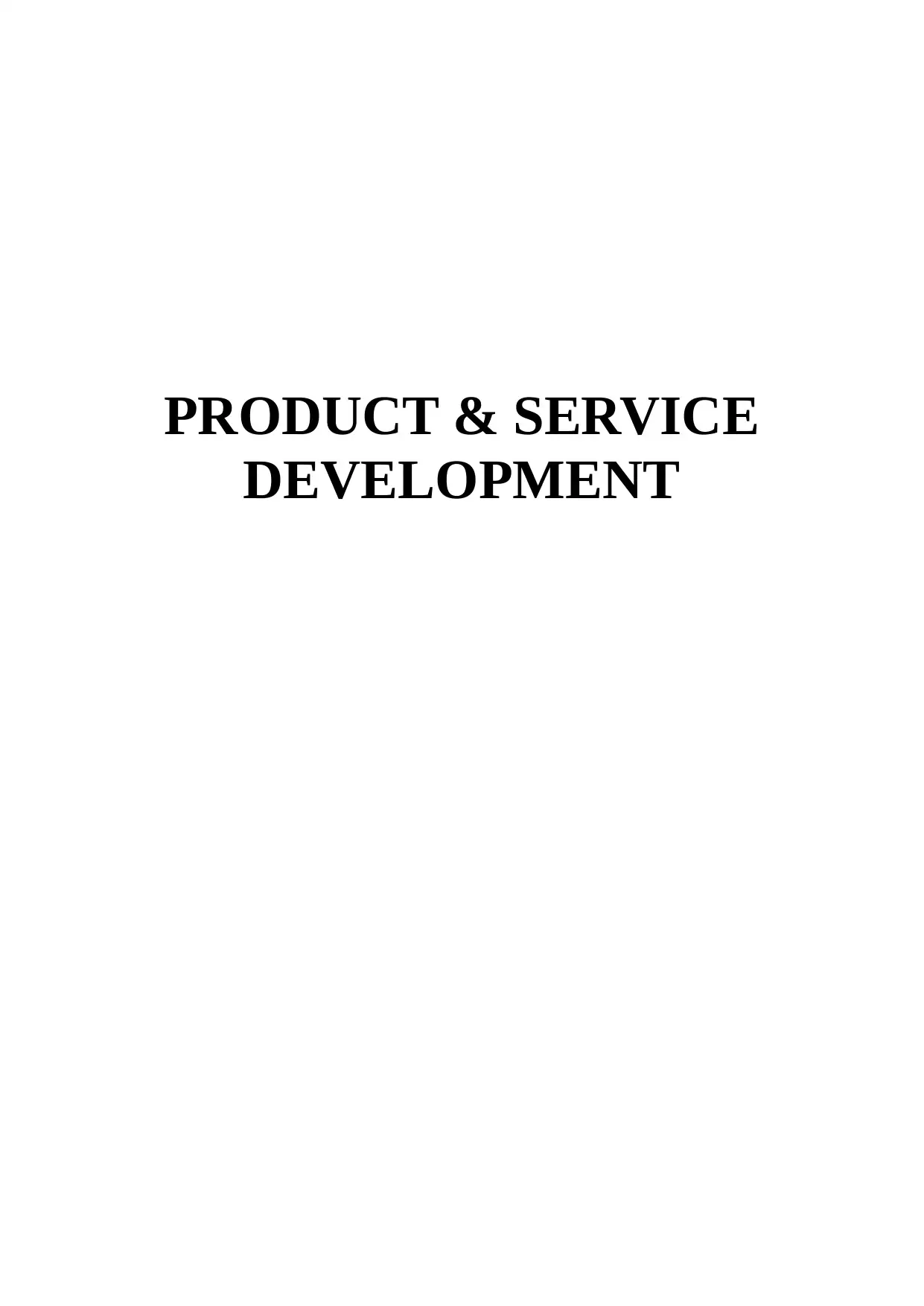
PRODUCT & SERVICE
DEVELOPMENT
DEVELOPMENT
Paraphrase This Document
Need a fresh take? Get an instant paraphrase of this document with our AI Paraphraser
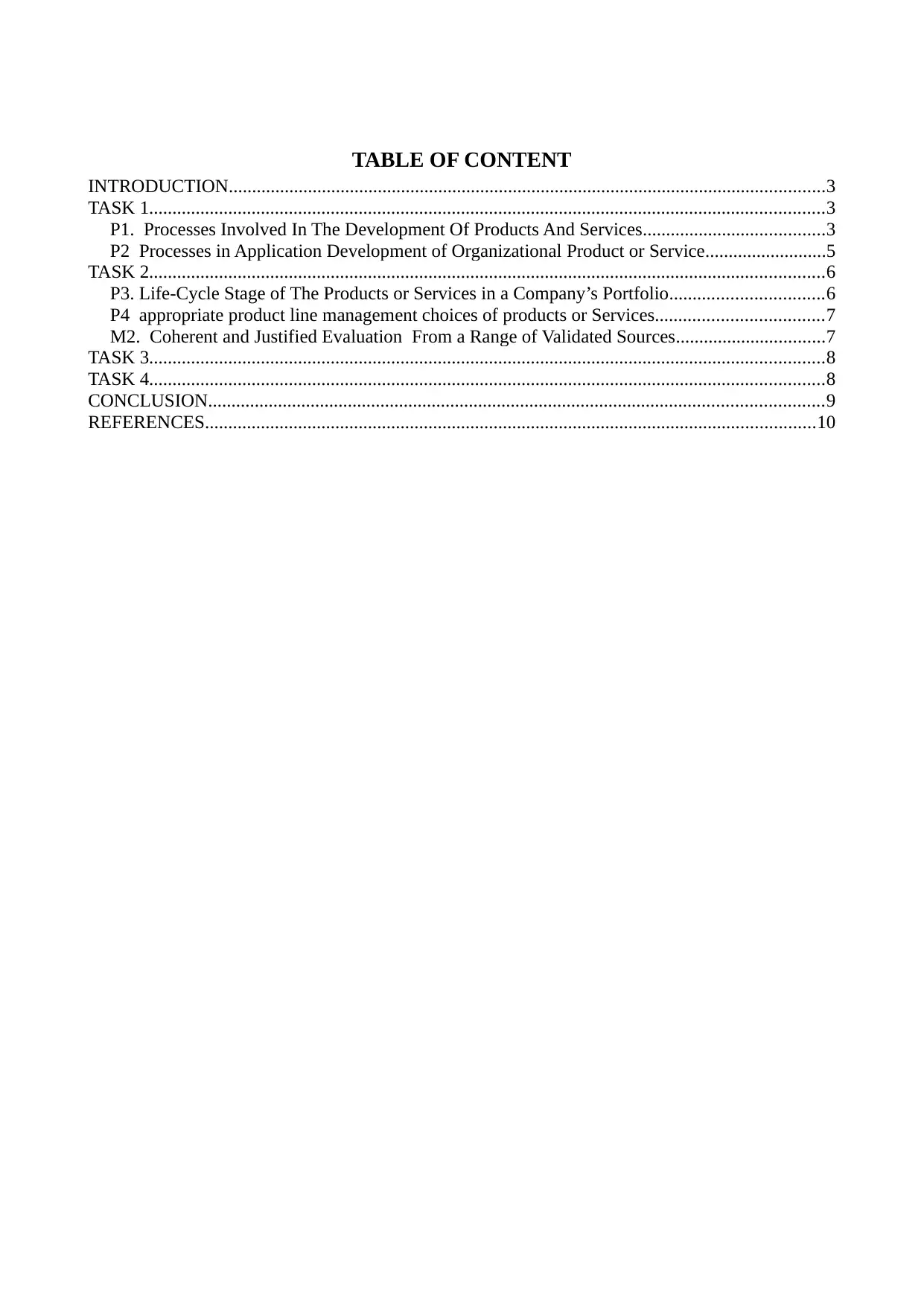
TABLE OF CONTENT
INTRODUCTION................................................................................................................................3
TASK 1.................................................................................................................................................3
P1. Processes Involved In The Development Of Products And Services.......................................3
P2 Processes in Application Development of Organizational Product or Service..........................5
TASK 2.................................................................................................................................................6
P3. Life-Cycle Stage of The Products or Services in a Company’s Portfolio.................................6
P4 appropriate product line management choices of products or Services....................................7
M2. Coherent and Justified Evaluation From a Range of Validated Sources................................7
TASK 3.................................................................................................................................................8
TASK 4.................................................................................................................................................8
CONCLUSION....................................................................................................................................9
REFERENCES...................................................................................................................................10
INTRODUCTION................................................................................................................................3
TASK 1.................................................................................................................................................3
P1. Processes Involved In The Development Of Products And Services.......................................3
P2 Processes in Application Development of Organizational Product or Service..........................5
TASK 2.................................................................................................................................................6
P3. Life-Cycle Stage of The Products or Services in a Company’s Portfolio.................................6
P4 appropriate product line management choices of products or Services....................................7
M2. Coherent and Justified Evaluation From a Range of Validated Sources................................7
TASK 3.................................................................................................................................................8
TASK 4.................................................................................................................................................8
CONCLUSION....................................................................................................................................9
REFERENCES...................................................................................................................................10
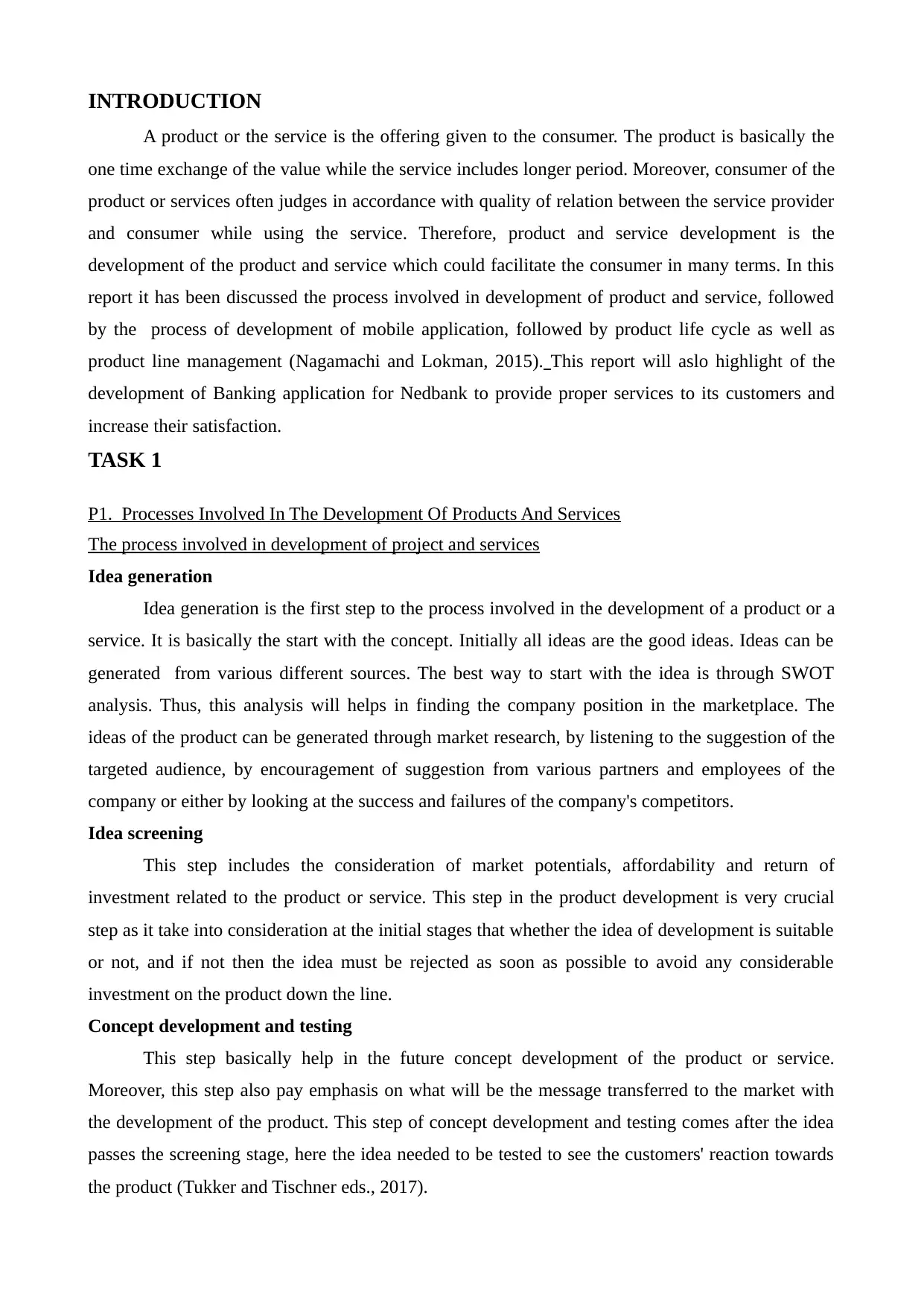
INTRODUCTION
A product or the service is the offering given to the consumer. The product is basically the
one time exchange of the value while the service includes longer period. Moreover, consumer of the
product or services often judges in accordance with quality of relation between the service provider
and consumer while using the service. Therefore, product and service development is the
development of the product and service which could facilitate the consumer in many terms. In this
report it has been discussed the process involved in development of product and service, followed
by the process of development of mobile application, followed by product life cycle as well as
product line management (Nagamachi and Lokman, 2015). This report will aslo highlight of the
development of Banking application for Nedbank to provide proper services to its customers and
increase their satisfaction.
TASK 1
P1. Processes Involved In The Development Of Products And Services
The process involved in development of project and services
Idea generation
Idea generation is the first step to the process involved in the development of a product or a
service. It is basically the start with the concept. Initially all ideas are the good ideas. Ideas can be
generated from various different sources. The best way to start with the idea is through SWOT
analysis. Thus, this analysis will helps in finding the company position in the marketplace. The
ideas of the product can be generated through market research, by listening to the suggestion of the
targeted audience, by encouragement of suggestion from various partners and employees of the
company or either by looking at the success and failures of the company's competitors.
Idea screening
This step includes the consideration of market potentials, affordability and return of
investment related to the product or service. This step in the product development is very crucial
step as it take into consideration at the initial stages that whether the idea of development is suitable
or not, and if not then the idea must be rejected as soon as possible to avoid any considerable
investment on the product down the line.
Concept development and testing
This step basically help in the future concept development of the product or service.
Moreover, this step also pay emphasis on what will be the message transferred to the market with
the development of the product. This step of concept development and testing comes after the idea
passes the screening stage, here the idea needed to be tested to see the customers' reaction towards
the product (Tukker and Tischner eds., 2017).
A product or the service is the offering given to the consumer. The product is basically the
one time exchange of the value while the service includes longer period. Moreover, consumer of the
product or services often judges in accordance with quality of relation between the service provider
and consumer while using the service. Therefore, product and service development is the
development of the product and service which could facilitate the consumer in many terms. In this
report it has been discussed the process involved in development of product and service, followed
by the process of development of mobile application, followed by product life cycle as well as
product line management (Nagamachi and Lokman, 2015). This report will aslo highlight of the
development of Banking application for Nedbank to provide proper services to its customers and
increase their satisfaction.
TASK 1
P1. Processes Involved In The Development Of Products And Services
The process involved in development of project and services
Idea generation
Idea generation is the first step to the process involved in the development of a product or a
service. It is basically the start with the concept. Initially all ideas are the good ideas. Ideas can be
generated from various different sources. The best way to start with the idea is through SWOT
analysis. Thus, this analysis will helps in finding the company position in the marketplace. The
ideas of the product can be generated through market research, by listening to the suggestion of the
targeted audience, by encouragement of suggestion from various partners and employees of the
company or either by looking at the success and failures of the company's competitors.
Idea screening
This step includes the consideration of market potentials, affordability and return of
investment related to the product or service. This step in the product development is very crucial
step as it take into consideration at the initial stages that whether the idea of development is suitable
or not, and if not then the idea must be rejected as soon as possible to avoid any considerable
investment on the product down the line.
Concept development and testing
This step basically help in the future concept development of the product or service.
Moreover, this step also pay emphasis on what will be the message transferred to the market with
the development of the product. This step of concept development and testing comes after the idea
passes the screening stage, here the idea needed to be tested to see the customers' reaction towards
the product (Tukker and Tischner eds., 2017).
⊘ This is a preview!⊘
Do you want full access?
Subscribe today to unlock all pages.

Trusted by 1+ million students worldwide
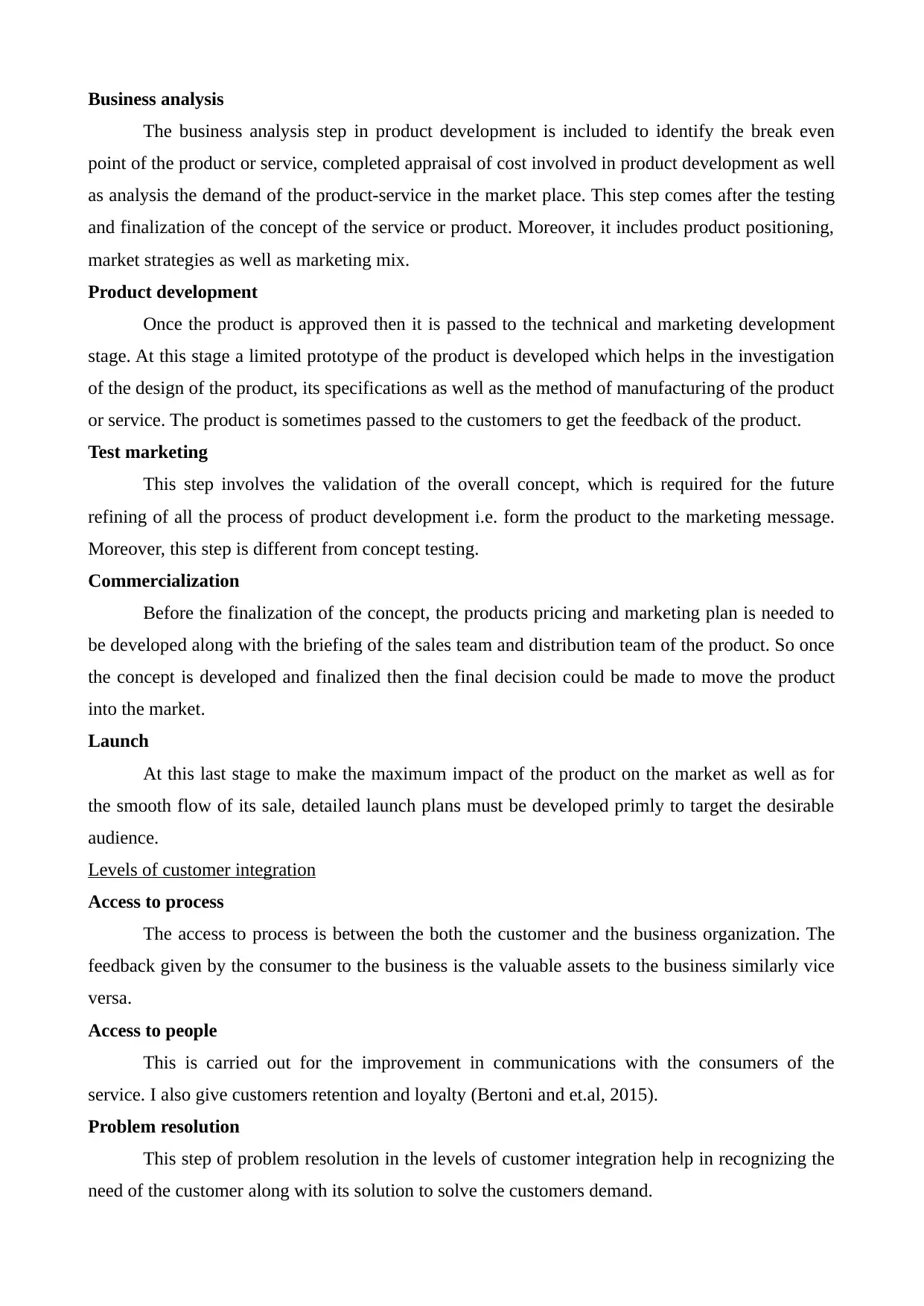
Business analysis
The business analysis step in product development is included to identify the break even
point of the product or service, completed appraisal of cost involved in product development as well
as analysis the demand of the product-service in the market place. This step comes after the testing
and finalization of the concept of the service or product. Moreover, it includes product positioning,
market strategies as well as marketing mix.
Product development
Once the product is approved then it is passed to the technical and marketing development
stage. At this stage a limited prototype of the product is developed which helps in the investigation
of the design of the product, its specifications as well as the method of manufacturing of the product
or service. The product is sometimes passed to the customers to get the feedback of the product.
Test marketing
This step involves the validation of the overall concept, which is required for the future
refining of all the process of product development i.e. form the product to the marketing message.
Moreover, this step is different from concept testing.
Commercialization
Before the finalization of the concept, the products pricing and marketing plan is needed to
be developed along with the briefing of the sales team and distribution team of the product. So once
the concept is developed and finalized then the final decision could be made to move the product
into the market.
Launch
At this last stage to make the maximum impact of the product on the market as well as for
the smooth flow of its sale, detailed launch plans must be developed primly to target the desirable
audience.
Levels of customer integration
Access to process
The access to process is between the both the customer and the business organization. The
feedback given by the consumer to the business is the valuable assets to the business similarly vice
versa.
Access to people
This is carried out for the improvement in communications with the consumers of the
service. I also give customers retention and loyalty (Bertoni and et.al, 2015).
Problem resolution
This step of problem resolution in the levels of customer integration help in recognizing the
need of the customer along with its solution to solve the customers demand.
The business analysis step in product development is included to identify the break even
point of the product or service, completed appraisal of cost involved in product development as well
as analysis the demand of the product-service in the market place. This step comes after the testing
and finalization of the concept of the service or product. Moreover, it includes product positioning,
market strategies as well as marketing mix.
Product development
Once the product is approved then it is passed to the technical and marketing development
stage. At this stage a limited prototype of the product is developed which helps in the investigation
of the design of the product, its specifications as well as the method of manufacturing of the product
or service. The product is sometimes passed to the customers to get the feedback of the product.
Test marketing
This step involves the validation of the overall concept, which is required for the future
refining of all the process of product development i.e. form the product to the marketing message.
Moreover, this step is different from concept testing.
Commercialization
Before the finalization of the concept, the products pricing and marketing plan is needed to
be developed along with the briefing of the sales team and distribution team of the product. So once
the concept is developed and finalized then the final decision could be made to move the product
into the market.
Launch
At this last stage to make the maximum impact of the product on the market as well as for
the smooth flow of its sale, detailed launch plans must be developed primly to target the desirable
audience.
Levels of customer integration
Access to process
The access to process is between the both the customer and the business organization. The
feedback given by the consumer to the business is the valuable assets to the business similarly vice
versa.
Access to people
This is carried out for the improvement in communications with the consumers of the
service. I also give customers retention and loyalty (Bertoni and et.al, 2015).
Problem resolution
This step of problem resolution in the levels of customer integration help in recognizing the
need of the customer along with its solution to solve the customers demand.
Paraphrase This Document
Need a fresh take? Get an instant paraphrase of this document with our AI Paraphraser
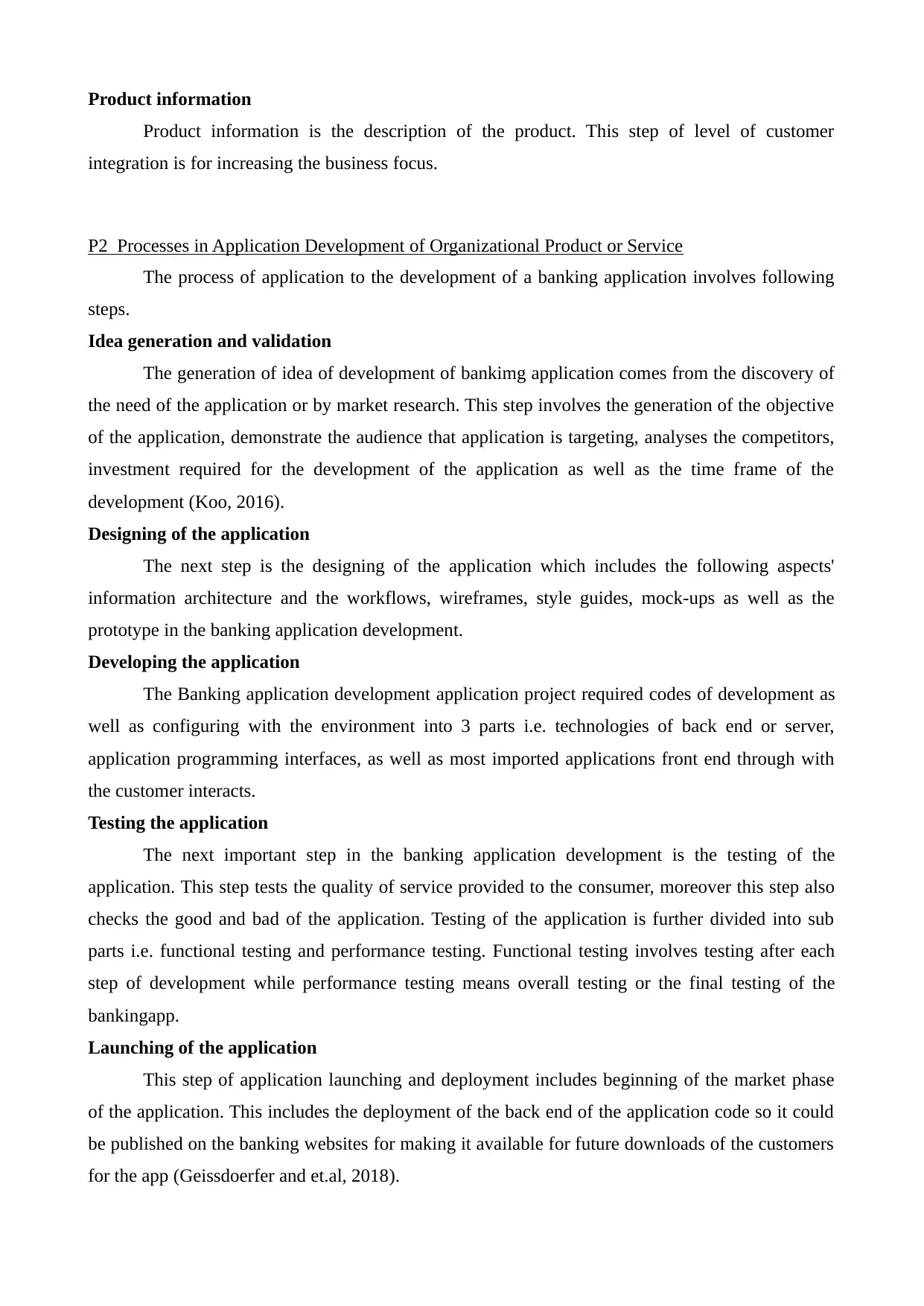
Product information
Product information is the description of the product. This step of level of customer
integration is for increasing the business focus.
P2 Processes in Application Development of Organizational Product or Service
The process of application to the development of a banking application involves following
steps.
Idea generation and validation
The generation of idea of development of bankimg application comes from the discovery of
the need of the application or by market research. This step involves the generation of the objective
of the application, demonstrate the audience that application is targeting, analyses the competitors,
investment required for the development of the application as well as the time frame of the
development (Koo, 2016).
Designing of the application
The next step is the designing of the application which includes the following aspects'
information architecture and the workflows, wireframes, style guides, mock-ups as well as the
prototype in the banking application development.
Developing the application
The Banking application development application project required codes of development as
well as configuring with the environment into 3 parts i.e. technologies of back end or server,
application programming interfaces, as well as most imported applications front end through with
the customer interacts.
Testing the application
The next important step in the banking application development is the testing of the
application. This step tests the quality of service provided to the consumer, moreover this step also
checks the good and bad of the application. Testing of the application is further divided into sub
parts i.e. functional testing and performance testing. Functional testing involves testing after each
step of development while performance testing means overall testing or the final testing of the
bankingapp.
Launching of the application
This step of application launching and deployment includes beginning of the market phase
of the application. This includes the deployment of the back end of the application code so it could
be published on the banking websites for making it available for future downloads of the customers
for the app (Geissdoerfer and et.al, 2018).
Product information is the description of the product. This step of level of customer
integration is for increasing the business focus.
P2 Processes in Application Development of Organizational Product or Service
The process of application to the development of a banking application involves following
steps.
Idea generation and validation
The generation of idea of development of bankimg application comes from the discovery of
the need of the application or by market research. This step involves the generation of the objective
of the application, demonstrate the audience that application is targeting, analyses the competitors,
investment required for the development of the application as well as the time frame of the
development (Koo, 2016).
Designing of the application
The next step is the designing of the application which includes the following aspects'
information architecture and the workflows, wireframes, style guides, mock-ups as well as the
prototype in the banking application development.
Developing the application
The Banking application development application project required codes of development as
well as configuring with the environment into 3 parts i.e. technologies of back end or server,
application programming interfaces, as well as most imported applications front end through with
the customer interacts.
Testing the application
The next important step in the banking application development is the testing of the
application. This step tests the quality of service provided to the consumer, moreover this step also
checks the good and bad of the application. Testing of the application is further divided into sub
parts i.e. functional testing and performance testing. Functional testing involves testing after each
step of development while performance testing means overall testing or the final testing of the
bankingapp.
Launching of the application
This step of application launching and deployment includes beginning of the market phase
of the application. This includes the deployment of the back end of the application code so it could
be published on the banking websites for making it available for future downloads of the customers
for the app (Geissdoerfer and et.al, 2018).
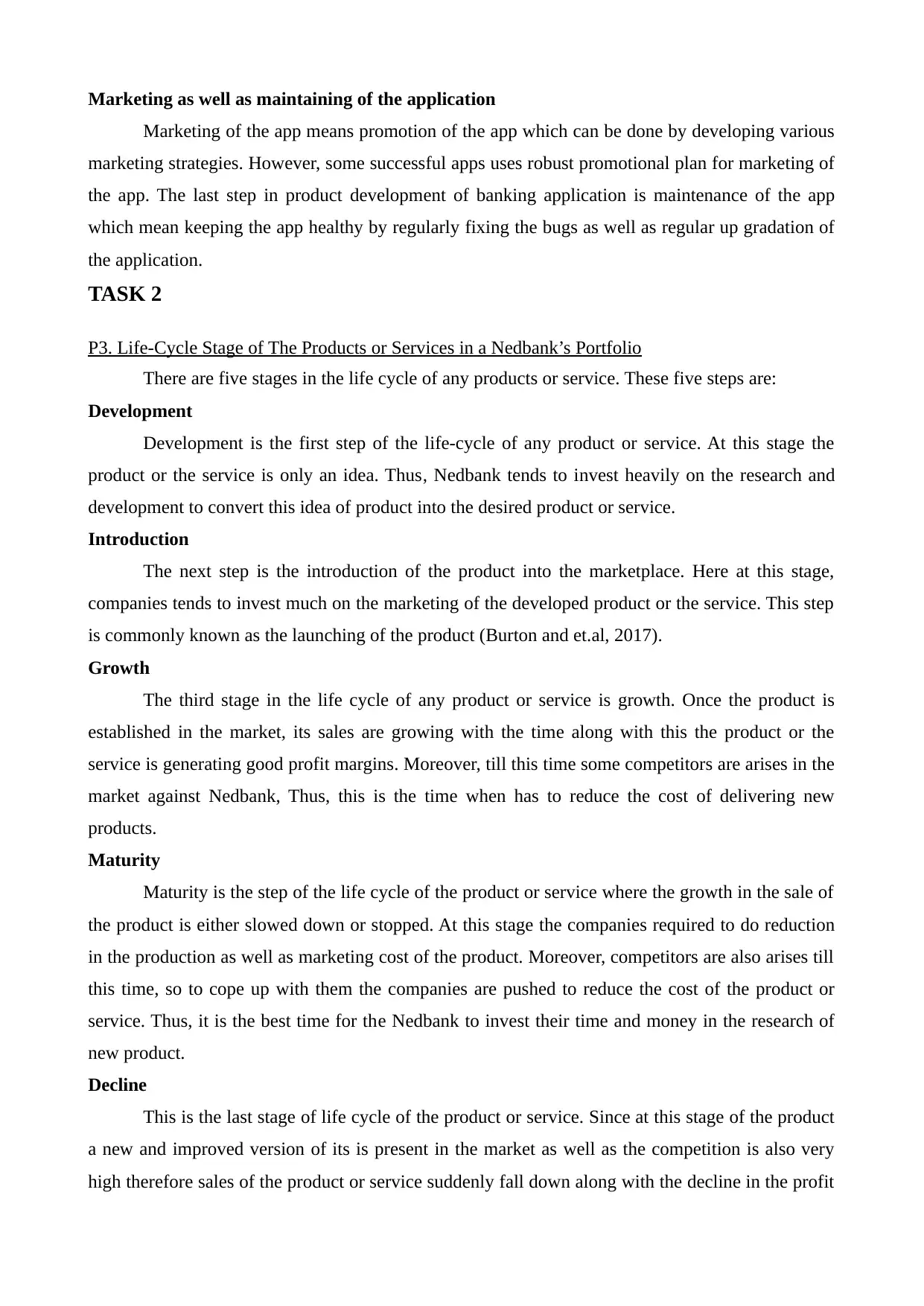
Marketing as well as maintaining of the application
Marketing of the app means promotion of the app which can be done by developing various
marketing strategies. However, some successful apps uses robust promotional plan for marketing of
the app. The last step in product development of banking application is maintenance of the app
which mean keeping the app healthy by regularly fixing the bugs as well as regular up gradation of
the application.
TASK 2
P3. Life-Cycle Stage of The Products or Services in a Nedbank’s Portfolio
There are five stages in the life cycle of any products or service. These five steps are:
Development
Development is the first step of the life-cycle of any product or service. At this stage the
product or the service is only an idea. Thus, Nedbank tends to invest heavily on the research and
development to convert this idea of product into the desired product or service.
Introduction
The next step is the introduction of the product into the marketplace. Here at this stage,
companies tends to invest much on the marketing of the developed product or the service. This step
is commonly known as the launching of the product (Burton and et.al, 2017).
Growth
The third stage in the life cycle of any product or service is growth. Once the product is
established in the market, its sales are growing with the time along with this the product or the
service is generating good profit margins. Moreover, till this time some competitors are arises in the
market against Nedbank, Thus, this is the time when has to reduce the cost of delivering new
products.
Maturity
Maturity is the step of the life cycle of the product or service where the growth in the sale of
the product is either slowed down or stopped. At this stage the companies required to do reduction
in the production as well as marketing cost of the product. Moreover, competitors are also arises till
this time, so to cope up with them the companies are pushed to reduce the cost of the product or
service. Thus, it is the best time for the Nedbank to invest their time and money in the research of
new product.
Decline
This is the last stage of life cycle of the product or service. Since at this stage of the product
a new and improved version of its is present in the market as well as the competition is also very
high therefore sales of the product or service suddenly fall down along with the decline in the profit
Marketing of the app means promotion of the app which can be done by developing various
marketing strategies. However, some successful apps uses robust promotional plan for marketing of
the app. The last step in product development of banking application is maintenance of the app
which mean keeping the app healthy by regularly fixing the bugs as well as regular up gradation of
the application.
TASK 2
P3. Life-Cycle Stage of The Products or Services in a Nedbank’s Portfolio
There are five stages in the life cycle of any products or service. These five steps are:
Development
Development is the first step of the life-cycle of any product or service. At this stage the
product or the service is only an idea. Thus, Nedbank tends to invest heavily on the research and
development to convert this idea of product into the desired product or service.
Introduction
The next step is the introduction of the product into the marketplace. Here at this stage,
companies tends to invest much on the marketing of the developed product or the service. This step
is commonly known as the launching of the product (Burton and et.al, 2017).
Growth
The third stage in the life cycle of any product or service is growth. Once the product is
established in the market, its sales are growing with the time along with this the product or the
service is generating good profit margins. Moreover, till this time some competitors are arises in the
market against Nedbank, Thus, this is the time when has to reduce the cost of delivering new
products.
Maturity
Maturity is the step of the life cycle of the product or service where the growth in the sale of
the product is either slowed down or stopped. At this stage the companies required to do reduction
in the production as well as marketing cost of the product. Moreover, competitors are also arises till
this time, so to cope up with them the companies are pushed to reduce the cost of the product or
service. Thus, it is the best time for the Nedbank to invest their time and money in the research of
new product.
Decline
This is the last stage of life cycle of the product or service. Since at this stage of the product
a new and improved version of its is present in the market as well as the competition is also very
high therefore sales of the product or service suddenly fall down along with the decline in the profit
⊘ This is a preview!⊘
Do you want full access?
Subscribe today to unlock all pages.

Trusted by 1+ million students worldwide
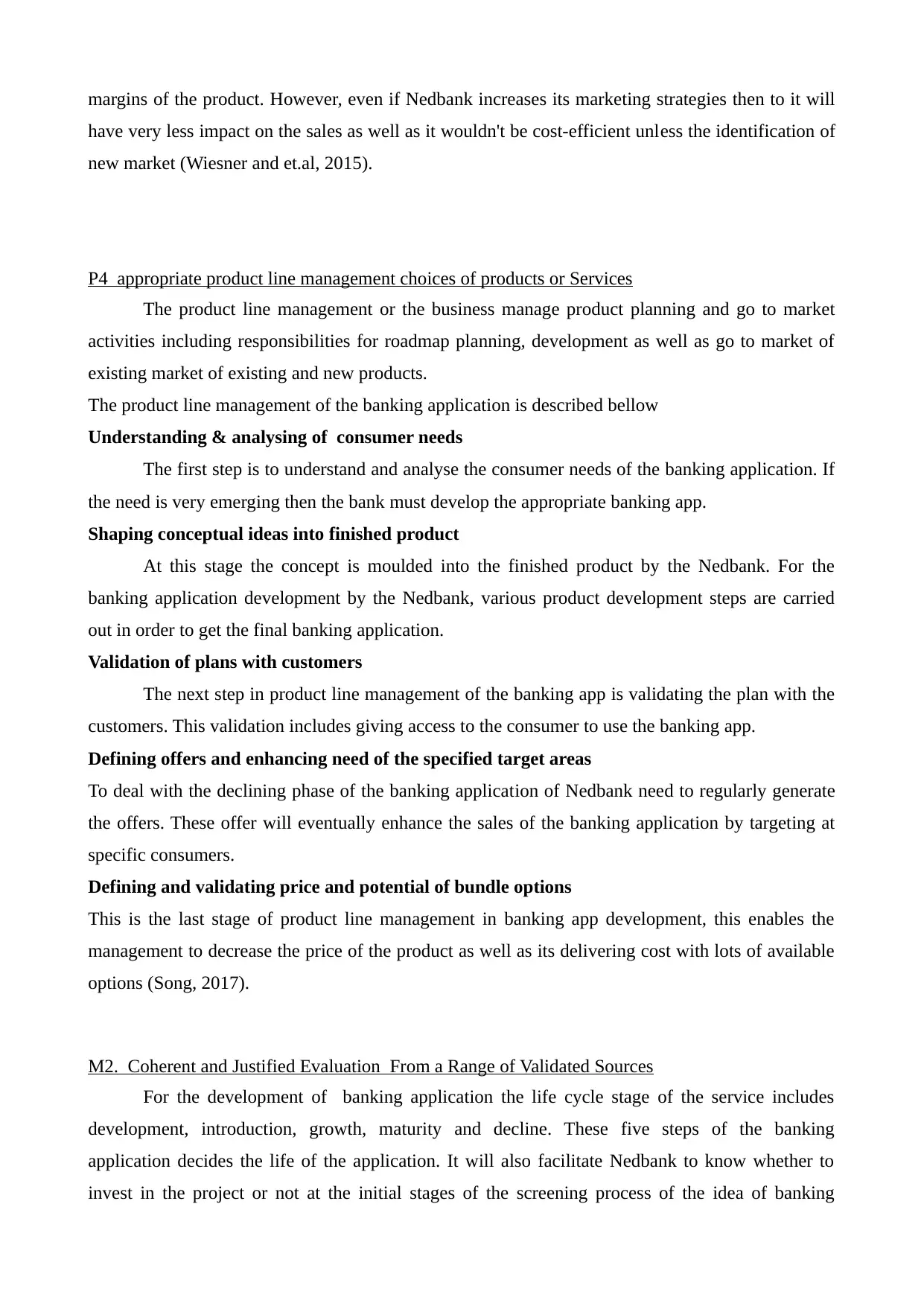
margins of the product. However, even if Nedbank increases its marketing strategies then to it will
have very less impact on the sales as well as it wouldn't be cost-efficient unless the identification of
new market (Wiesner and et.al, 2015).
P4 appropriate product line management choices of products or Services
The product line management or the business manage product planning and go to market
activities including responsibilities for roadmap planning, development as well as go to market of
existing market of existing and new products.
The product line management of the banking application is described bellow
Understanding & analysing of consumer needs
The first step is to understand and analyse the consumer needs of the banking application. If
the need is very emerging then the bank must develop the appropriate banking app.
Shaping conceptual ideas into finished product
At this stage the concept is moulded into the finished product by the Nedbank. For the
banking application development by the Nedbank, various product development steps are carried
out in order to get the final banking application.
Validation of plans with customers
The next step in product line management of the banking app is validating the plan with the
customers. This validation includes giving access to the consumer to use the banking app.
Defining offers and enhancing need of the specified target areas
To deal with the declining phase of the banking application of Nedbank need to regularly generate
the offers. These offer will eventually enhance the sales of the banking application by targeting at
specific consumers.
Defining and validating price and potential of bundle options
This is the last stage of product line management in banking app development, this enables the
management to decrease the price of the product as well as its delivering cost with lots of available
options (Song, 2017).
M2. Coherent and Justified Evaluation From a Range of Validated Sources
For the development of banking application the life cycle stage of the service includes
development, introduction, growth, maturity and decline. These five steps of the banking
application decides the life of the application. It will also facilitate Nedbank to know whether to
invest in the project or not at the initial stages of the screening process of the idea of banking
have very less impact on the sales as well as it wouldn't be cost-efficient unless the identification of
new market (Wiesner and et.al, 2015).
P4 appropriate product line management choices of products or Services
The product line management or the business manage product planning and go to market
activities including responsibilities for roadmap planning, development as well as go to market of
existing market of existing and new products.
The product line management of the banking application is described bellow
Understanding & analysing of consumer needs
The first step is to understand and analyse the consumer needs of the banking application. If
the need is very emerging then the bank must develop the appropriate banking app.
Shaping conceptual ideas into finished product
At this stage the concept is moulded into the finished product by the Nedbank. For the
banking application development by the Nedbank, various product development steps are carried
out in order to get the final banking application.
Validation of plans with customers
The next step in product line management of the banking app is validating the plan with the
customers. This validation includes giving access to the consumer to use the banking app.
Defining offers and enhancing need of the specified target areas
To deal with the declining phase of the banking application of Nedbank need to regularly generate
the offers. These offer will eventually enhance the sales of the banking application by targeting at
specific consumers.
Defining and validating price and potential of bundle options
This is the last stage of product line management in banking app development, this enables the
management to decrease the price of the product as well as its delivering cost with lots of available
options (Song, 2017).
M2. Coherent and Justified Evaluation From a Range of Validated Sources
For the development of banking application the life cycle stage of the service includes
development, introduction, growth, maturity and decline. These five steps of the banking
application decides the life of the application. It will also facilitate Nedbank to know whether to
invest in the project or not at the initial stages of the screening process of the idea of banking
Paraphrase This Document
Need a fresh take? Get an instant paraphrase of this document with our AI Paraphraser
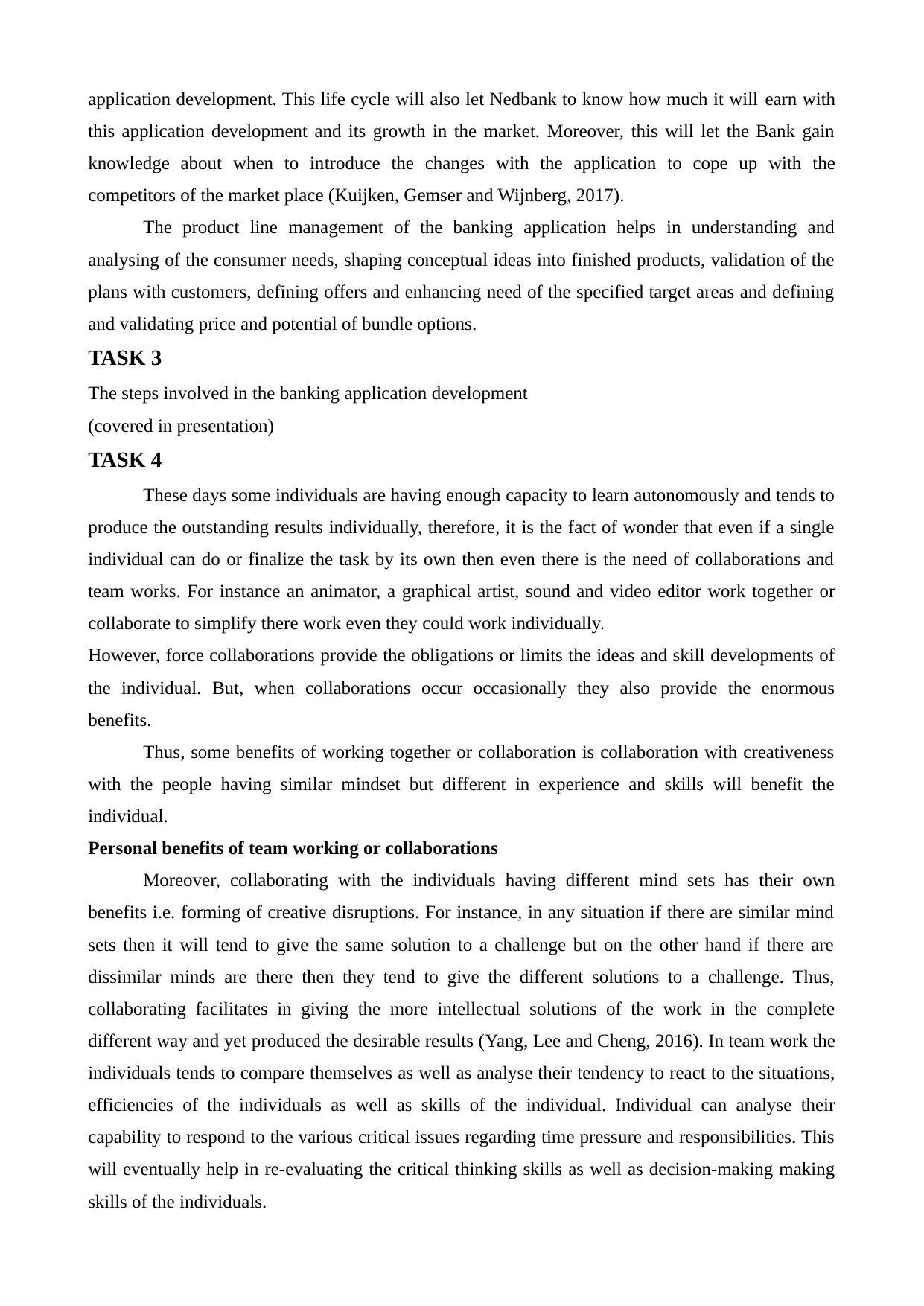
application development. This life cycle will also let Nedbank to know how much it will earn with
this application development and its growth in the market. Moreover, this will let the Bank gain
knowledge about when to introduce the changes with the application to cope up with the
competitors of the market place (Kuijken, Gemser and Wijnberg, 2017).
The product line management of the banking application helps in understanding and
analysing of the consumer needs, shaping conceptual ideas into finished products, validation of the
plans with customers, defining offers and enhancing need of the specified target areas and defining
and validating price and potential of bundle options.
TASK 3
The steps involved in the banking application development
(covered in presentation)
TASK 4
These days some individuals are having enough capacity to learn autonomously and tends to
produce the outstanding results individually, therefore, it is the fact of wonder that even if a single
individual can do or finalize the task by its own then even there is the need of collaborations and
team works. For instance an animator, a graphical artist, sound and video editor work together or
collaborate to simplify there work even they could work individually.
However, force collaborations provide the obligations or limits the ideas and skill developments of
the individual. But, when collaborations occur occasionally they also provide the enormous
benefits.
Thus, some benefits of working together or collaboration is collaboration with creativeness
with the people having similar mindset but different in experience and skills will benefit the
individual.
Personal benefits of team working or collaborations
Moreover, collaborating with the individuals having different mind sets has their own
benefits i.e. forming of creative disruptions. For instance, in any situation if there are similar mind
sets then it will tend to give the same solution to a challenge but on the other hand if there are
dissimilar minds are there then they tend to give the different solutions to a challenge. Thus,
collaborating facilitates in giving the more intellectual solutions of the work in the complete
different way and yet produced the desirable results (Yang, Lee and Cheng, 2016). In team work the
individuals tends to compare themselves as well as analyse their tendency to react to the situations,
efficiencies of the individuals as well as skills of the individual. Individual can analyse their
capability to respond to the various critical issues regarding time pressure and responsibilities. This
will eventually help in re-evaluating the critical thinking skills as well as decision-making making
skills of the individuals.
this application development and its growth in the market. Moreover, this will let the Bank gain
knowledge about when to introduce the changes with the application to cope up with the
competitors of the market place (Kuijken, Gemser and Wijnberg, 2017).
The product line management of the banking application helps in understanding and
analysing of the consumer needs, shaping conceptual ideas into finished products, validation of the
plans with customers, defining offers and enhancing need of the specified target areas and defining
and validating price and potential of bundle options.
TASK 3
The steps involved in the banking application development
(covered in presentation)
TASK 4
These days some individuals are having enough capacity to learn autonomously and tends to
produce the outstanding results individually, therefore, it is the fact of wonder that even if a single
individual can do or finalize the task by its own then even there is the need of collaborations and
team works. For instance an animator, a graphical artist, sound and video editor work together or
collaborate to simplify there work even they could work individually.
However, force collaborations provide the obligations or limits the ideas and skill developments of
the individual. But, when collaborations occur occasionally they also provide the enormous
benefits.
Thus, some benefits of working together or collaboration is collaboration with creativeness
with the people having similar mindset but different in experience and skills will benefit the
individual.
Personal benefits of team working or collaborations
Moreover, collaborating with the individuals having different mind sets has their own
benefits i.e. forming of creative disruptions. For instance, in any situation if there are similar mind
sets then it will tend to give the same solution to a challenge but on the other hand if there are
dissimilar minds are there then they tend to give the different solutions to a challenge. Thus,
collaborating facilitates in giving the more intellectual solutions of the work in the complete
different way and yet produced the desirable results (Yang, Lee and Cheng, 2016). In team work the
individuals tends to compare themselves as well as analyse their tendency to react to the situations,
efficiencies of the individuals as well as skills of the individual. Individual can analyse their
capability to respond to the various critical issues regarding time pressure and responsibilities. This
will eventually help in re-evaluating the critical thinking skills as well as decision-making making
skills of the individuals.
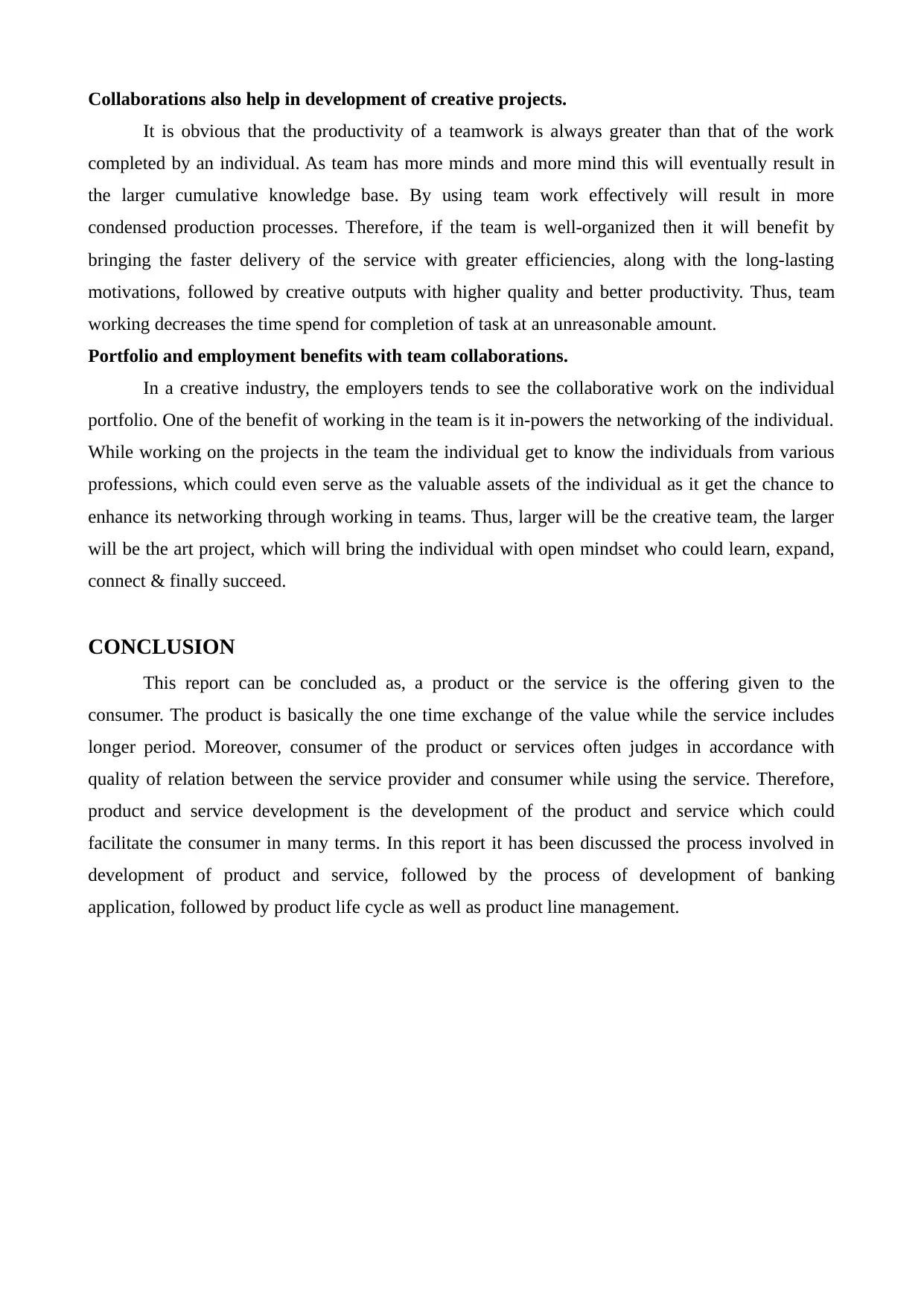
Collaborations also help in development of creative projects.
It is obvious that the productivity of a teamwork is always greater than that of the work
completed by an individual. As team has more minds and more mind this will eventually result in
the larger cumulative knowledge base. By using team work effectively will result in more
condensed production processes. Therefore, if the team is well-organized then it will benefit by
bringing the faster delivery of the service with greater efficiencies, along with the long-lasting
motivations, followed by creative outputs with higher quality and better productivity. Thus, team
working decreases the time spend for completion of task at an unreasonable amount.
Portfolio and employment benefits with team collaborations.
In a creative industry, the employers tends to see the collaborative work on the individual
portfolio. One of the benefit of working in the team is it in-powers the networking of the individual.
While working on the projects in the team the individual get to know the individuals from various
professions, which could even serve as the valuable assets of the individual as it get the chance to
enhance its networking through working in teams. Thus, larger will be the creative team, the larger
will be the art project, which will bring the individual with open mindset who could learn, expand,
connect & finally succeed.
CONCLUSION
This report can be concluded as, a product or the service is the offering given to the
consumer. The product is basically the one time exchange of the value while the service includes
longer period. Moreover, consumer of the product or services often judges in accordance with
quality of relation between the service provider and consumer while using the service. Therefore,
product and service development is the development of the product and service which could
facilitate the consumer in many terms. In this report it has been discussed the process involved in
development of product and service, followed by the process of development of banking
application, followed by product life cycle as well as product line management.
It is obvious that the productivity of a teamwork is always greater than that of the work
completed by an individual. As team has more minds and more mind this will eventually result in
the larger cumulative knowledge base. By using team work effectively will result in more
condensed production processes. Therefore, if the team is well-organized then it will benefit by
bringing the faster delivery of the service with greater efficiencies, along with the long-lasting
motivations, followed by creative outputs with higher quality and better productivity. Thus, team
working decreases the time spend for completion of task at an unreasonable amount.
Portfolio and employment benefits with team collaborations.
In a creative industry, the employers tends to see the collaborative work on the individual
portfolio. One of the benefit of working in the team is it in-powers the networking of the individual.
While working on the projects in the team the individual get to know the individuals from various
professions, which could even serve as the valuable assets of the individual as it get the chance to
enhance its networking through working in teams. Thus, larger will be the creative team, the larger
will be the art project, which will bring the individual with open mindset who could learn, expand,
connect & finally succeed.
CONCLUSION
This report can be concluded as, a product or the service is the offering given to the
consumer. The product is basically the one time exchange of the value while the service includes
longer period. Moreover, consumer of the product or services often judges in accordance with
quality of relation between the service provider and consumer while using the service. Therefore,
product and service development is the development of the product and service which could
facilitate the consumer in many terms. In this report it has been discussed the process involved in
development of product and service, followed by the process of development of banking
application, followed by product life cycle as well as product line management.
⊘ This is a preview!⊘
Do you want full access?
Subscribe today to unlock all pages.

Trusted by 1+ million students worldwide
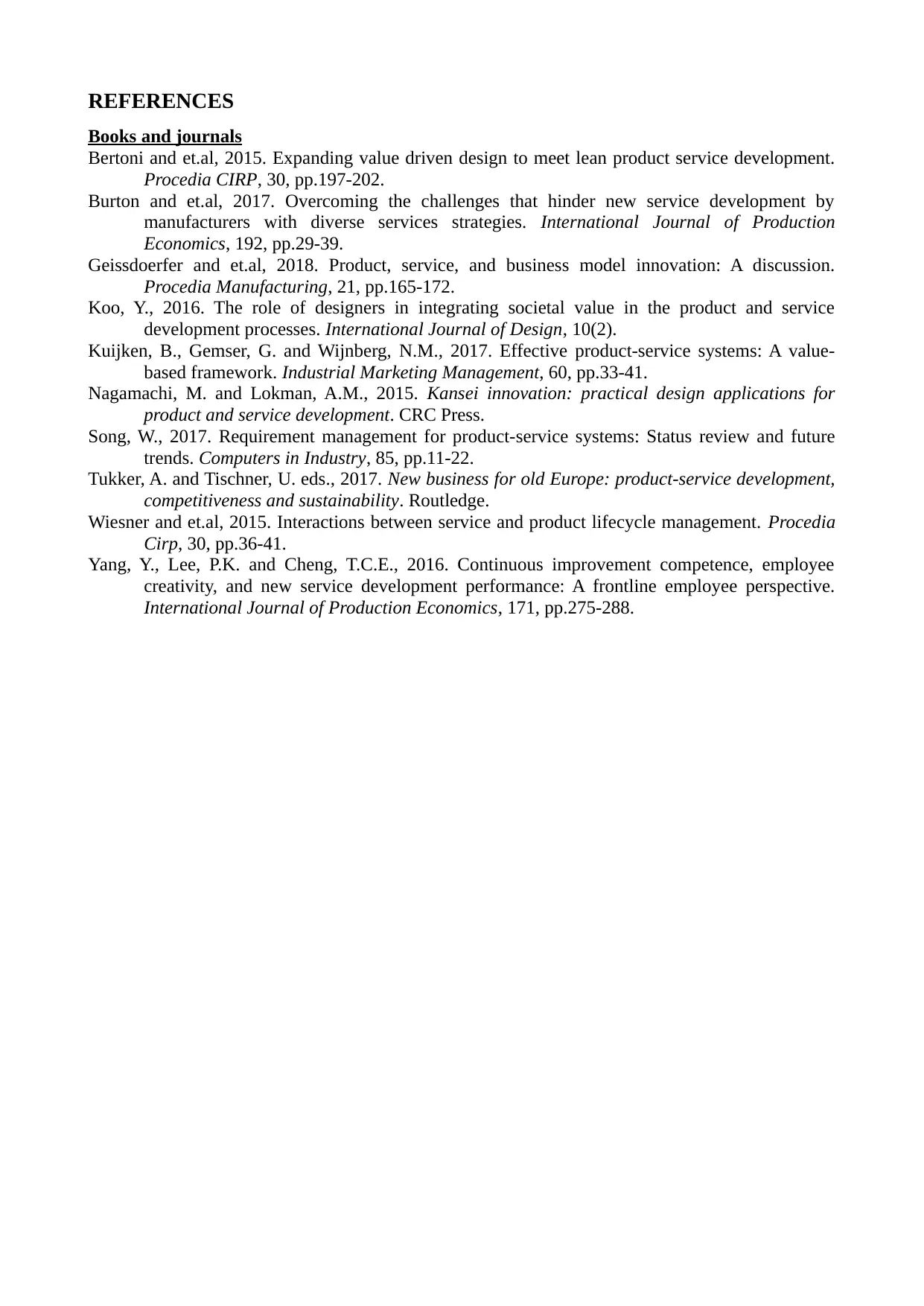
REFERENCES
Books and journals
Bertoni and et.al, 2015. Expanding value driven design to meet lean product service development.
Procedia CIRP, 30, pp.197-202.
Burton and et.al, 2017. Overcoming the challenges that hinder new service development by
manufacturers with diverse services strategies. International Journal of Production
Economics, 192, pp.29-39.
Geissdoerfer and et.al, 2018. Product, service, and business model innovation: A discussion.
Procedia Manufacturing, 21, pp.165-172.
Koo, Y., 2016. The role of designers in integrating societal value in the product and service
development processes. International Journal of Design, 10(2).
Kuijken, B., Gemser, G. and Wijnberg, N.M., 2017. Effective product-service systems: A value-
based framework. Industrial Marketing Management, 60, pp.33-41.
Nagamachi, M. and Lokman, A.M., 2015. Kansei innovation: practical design applications for
product and service development. CRC Press.
Song, W., 2017. Requirement management for product-service systems: Status review and future
trends. Computers in Industry, 85, pp.11-22.
Tukker, A. and Tischner, U. eds., 2017. New business for old Europe: product-service development,
competitiveness and sustainability. Routledge.
Wiesner and et.al, 2015. Interactions between service and product lifecycle management. Procedia
Cirp, 30, pp.36-41.
Yang, Y., Lee, P.K. and Cheng, T.C.E., 2016. Continuous improvement competence, employee
creativity, and new service development performance: A frontline employee perspective.
International Journal of Production Economics, 171, pp.275-288.
Books and journals
Bertoni and et.al, 2015. Expanding value driven design to meet lean product service development.
Procedia CIRP, 30, pp.197-202.
Burton and et.al, 2017. Overcoming the challenges that hinder new service development by
manufacturers with diverse services strategies. International Journal of Production
Economics, 192, pp.29-39.
Geissdoerfer and et.al, 2018. Product, service, and business model innovation: A discussion.
Procedia Manufacturing, 21, pp.165-172.
Koo, Y., 2016. The role of designers in integrating societal value in the product and service
development processes. International Journal of Design, 10(2).
Kuijken, B., Gemser, G. and Wijnberg, N.M., 2017. Effective product-service systems: A value-
based framework. Industrial Marketing Management, 60, pp.33-41.
Nagamachi, M. and Lokman, A.M., 2015. Kansei innovation: practical design applications for
product and service development. CRC Press.
Song, W., 2017. Requirement management for product-service systems: Status review and future
trends. Computers in Industry, 85, pp.11-22.
Tukker, A. and Tischner, U. eds., 2017. New business for old Europe: product-service development,
competitiveness and sustainability. Routledge.
Wiesner and et.al, 2015. Interactions between service and product lifecycle management. Procedia
Cirp, 30, pp.36-41.
Yang, Y., Lee, P.K. and Cheng, T.C.E., 2016. Continuous improvement competence, employee
creativity, and new service development performance: A frontline employee perspective.
International Journal of Production Economics, 171, pp.275-288.
1 out of 10
Related Documents
Your All-in-One AI-Powered Toolkit for Academic Success.
+13062052269
info@desklib.com
Available 24*7 on WhatsApp / Email
![[object Object]](/_next/static/media/star-bottom.7253800d.svg)
Unlock your academic potential
Copyright © 2020–2025 A2Z Services. All Rights Reserved. Developed and managed by ZUCOL.




